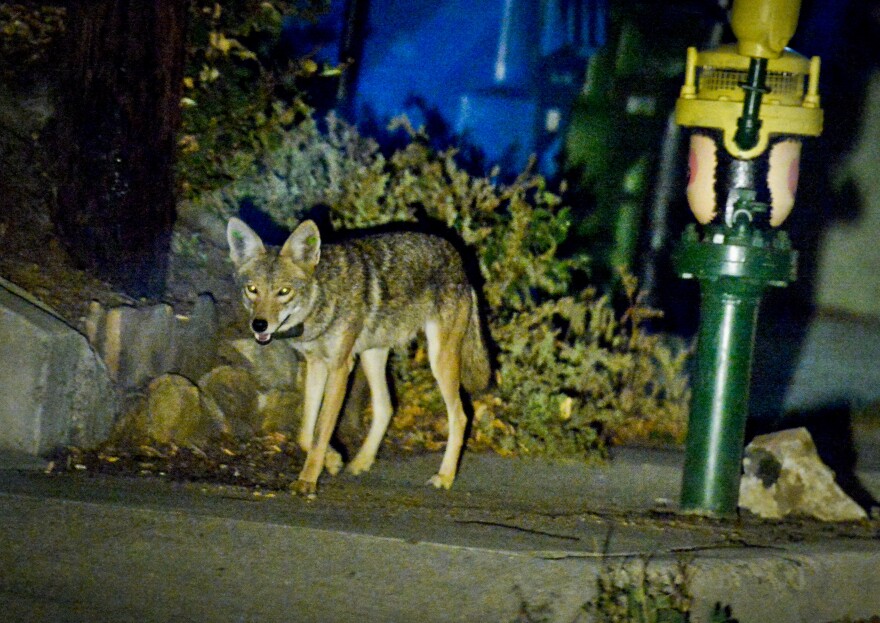This story is free to read because readers choose to support LAist. If you find value in independent local reporting, make a donation to power our newsroom today.
This archival content was originally written for and published on KPCC.org. Keep in mind that links and images may no longer work — and references may be outdated.
Coyote attacks are increasing in Southern California. Why?

Coyote attacks in Southern California appear to be on the rise.
In 2015, 11 people were bitten by coyotes in Los Angeles and Orange Counties, according to data from the California Department of Fish and Wildlife. That’s up from four in 2014 and just one in 2013.
Anecdotally, there have been at least 10 attacks so far in 2016, according to agency spokesman Andrew Hughan.
Three of those occurred in late July and early August, when coyotes bit three people around Grant Rey Park in Montebello. The brazenness of one of the attacks shocked wildlife officials: the animal came up behind a man who was standing and rifling through a trash can, making lots of noise. He went to the hospital with 19 puncture wounds.
“Coyotes should be afraid of people and wouldn't come anywhere near someone making that kind of noise,” Hughan said. “Why would they attack people? That’s the mystery.”
Coyote bites reported to California Department of Fish and Wildlife in LA and Orange Counties, 2012-2016
| Year | Bites |
|---|---|
| 2012 | 3 |
| 2013 | 1 |
| 2014 | 4 |
| 2015 | 11 |
| 2016 to date | at least 10* |
Data source: California Department of Fish and Wildlife. *2016 data is anecdotal.
There are a few theories.
“Whenever there’s one of these incidents, the first question I ask is if there’s something at the site they see as a reliable source of food,” said Travis Longcore, an assistant professor of landscape architecture at the University of Southern California who works on urban ecology issues.
Hughan said in the Montebello incident, garbage likely drew the coyotes into the park, and then they identified humans as a possible source of food, biting them to find out. Coyote attacks often involve small children or, in the case of the second Montebello attack, a man who was lying on the ground, because they are low to the ground.
Feral cats – and the food people leave for them – can also be a draw for coyotes. Longcore has observed an overlap between locations where people have received permits to trap feral cats and where coyotes have been sighted.
“Any time someone is leaving food out, that’s feeding all manner of wildlife that can get overabundant or problematic," Longcore said. "That’s a recipe for conflict."
Another theory is habitat loss. Thanks to the National Park Service’s pioneering research on urban coyotes in Los Angeles, we now know that coyotes can live in highly urbanized places, spending much of their time in vacant lots and back yards. They don’t necessarily need big open spaces like parks and natural areas.
But as development pressure increases, those places are being converted into homes and apartment buildings. Hughan says that could mean coyotes are being forced out of places they used to live and into conflict with humans.
Many people wonder if drought is forcing coyotes into more urban areas, but Justin Brown, who heads up the NPS’s urban coyote research project, has said previously that’s unlikely.
“Coyotes live in some areas that are incredibly dry and they’ve done quite well in these areas,” Brown told KPCC in July. “I don’t think water is a hindrance to them. Prey might be an issue if there isn’t as much grass for rabbits to eat.”
Others wonder if coyote populations are increasing in greater Los Angeles, but Hughan says that’s not true. “There’s no science to support that there are more animals,” he said. Indeed, Brown is hoping to determine if L.A.’s urban coyote population is increasing in future research.
The easiest way to avoid coyote attacks is not to feed coyotes directly or indirectly by leaving food and garbage out. Also, don’t let pets off leash unattended and report aggressive animals.
CDFW has killed five coyotes in Montebello, including one that was definitely involved in the recent attacks. The agency will resort to killing animals when they attack humans, although lethal control is not generally considered effective for population management, according to Los Angeles Animal Services.
A previous version of this story contained information that should not have been attributed to the National Park Service.







